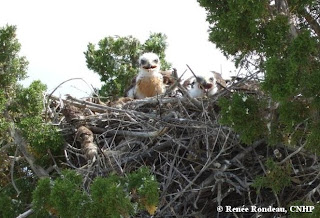This is the second year of the Colorado Natural Heritage Program's Southeast Colorado inventory, and we continue to discover the biological significance of private ranches in the area.
CNHP is surveying for rare plants, animals, and plant communities in the area and access generously granted by private landowners to at least 300,000 acres in SE Colorado has allowed CNHP to document the ecological significance that these native landscapes continue to support. Funding for this project is from Great Outdoors Colorado, Colorado Division of Wildlife, Colorado Cattleman’s Agricultural Land Trust, and private landowners.
In just a single day on one ranch we located 15 species of conservation concern, all with populations in excellent condition.

Echinocereus reichenbachii (Reichenbach's Hedgehog Cactus)
On another day in a different area we discovered evidence of the biodiversity of long ago.

Fossils such as this ammonite can be found in the area
 A close-up of a calcite crystal filled concretion
A close-up of a calcite crystal filled concretion
 A close-up of a calcite crystal filled concretion
A close-up of a calcite crystal filled concretionThese areas may have been biologically significant since the Cretaceous period (between 65 and 136 million years ago). The ancient shallow seas of those times supported a rich marine life complete with many types of ammonites, bivalves, sharks, and more. Today the fossilized seabeds form mesas, buttes, bluffs, and escarpments that are just as important to modern species, creating a distinct habitat that is critical for rare plants, animals, and plant communities. These sites are also rich in unusual geologic specimens, such as concretions filled with calcite crystals or others that resemble petrified wood.


Concretions resembling petrified wood
Today these buttes, bluffs, and escarpments are just as important to modern species, creating a distinct habitat that is critical for rare plants, animals, and plant communities.

Aspidoscelis neotesselata (Triploid Checkered Whiptail)
 Lesquerella calcicola (Rocky Mountain bladderpod)
Lesquerella calcicola (Rocky Mountain bladderpod)
 Red-tailed hawk nestlings
Red-tailed hawk nestlings
 Lesquerella calcicola (Rocky Mountain bladderpod)
Lesquerella calcicola (Rocky Mountain bladderpod)
 Red-tailed hawk nestlings
Red-tailed hawk nestlingsIn sharp contrast to the surrounding shortgrass prairie, these juniper breaks are populated with short trees and shrubs that provide important wildlife and livestock habitat, especially during winter storms.


These juniper breaks support old-growth junipers and rare plant habitat
We thank all of the landowners, partners, and all of our volunteers and interns for making this a success. Summer has just started so stay tuned for new discoveries!

Local landowner and Dina Clark (R)




No comments:
Post a Comment
Thanks for your comment!
Please note that all comments are moderated, so there may be a delay of some hours (especially over the weekend or at night Colorado time) before your comment shows up.